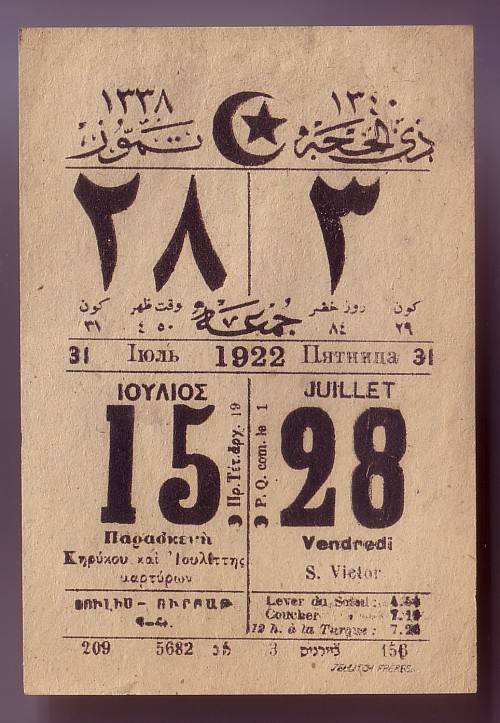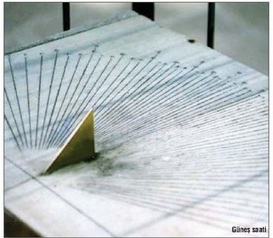
THE PULSE OF TIME: CALENDAR
Throughout history, calendars have been made based on either the movements of the Sun, the movements of the Moon, or both. The solar year (sun year) refers to the time it takes for the Earth to orbit the Sun. It is 365.242 days long. The lunar year (moon year) refers to the time it takes for the moon to orbit the Earth 12 times. It is 354.367 days long. The solar year is 11 days longer than the lunar year.
Month Names from Babylon
In ancient Egypt, where life was based on agriculture, a solar calendar was used, consisting of 12 months and 365 days. Each month had 30 days, with an additional 5 days added at the end. Each day was divided into two parts, each consisting of 12 hours. In Mesopotamia, which was highly advanced in astronomy, a lunar-solar calendar was also used. This calendar consisted of 12 months totaling 354 days, with an additional short month of 11 days added. In Babylon, a month of 33 days was added every three years to ensure that the New Year always fell on April 1st. The month names such as Naysan (April), Haziran (June), Tammuz (July), Aylul (September), Tishrin Awwal (October) Tishrin Thani (November), Qanun Awwal (December) Qanun Thani (January), Shubat (February), used in Turkey and the Middle East today, are all derived from Babylon. Arabs call March as Adar, May as Aiar and August as Ab.
The ancient Turks, Chinese, and Aztecs used a lunar-solar calendar. Each year was assigned an animal name, and every 12 years, these years would repeat in a cycle. This made it easier to remember ages and historical events.
The Assyrians used the Seleucid calendar, which was a solar calendar adjusted every four years to include leap years. The beginning of this calendar, a continuation of the ancient Greek calendar, was in 312 BCE, the entry of Seleucus, one of Alexander the Great's generals, into Babylon. Even today, Jews use a lunar calendar that takes the date of humanity's creation, which they consider to be in 3761 BCE, as its starting point. To reconcile the difference with the solar year, an additional month is added to the years every three years.

Give Us Back Our 10 Days
In ancient Rome, a lunar calendar with 12 months and 354 days was used. To prevent seasonal drift, 22 or 23 days were added every two years. The first month of the year was March before Caesar. Its beginning was in the year 753 BC when Rome was founded. Under the orders of Julius Caesar, some corrections were made to this calendar by the Alexandrian astronomer Sosigenes in 46 BC. This new calendar, based on the sun, is known as the Julian Calendar. A year is 365.25 days long. Starting from March, months alternated with 31 days for odd months and 30 days for even months. The last month, February, had 28 days for three years and 29 days for the fourth year.
A month is also named after Caesar: July. Emperor Augustus, not to be outdone by his predecessor, renamed Sextilis, which was previously the sixth month and is now the eighth month, after himself; furthermore, he took 1 day from February, which had 29 days, and added it to make this month 31 days long. Thus, the odd-even month system established by Caesar was disrupted.
Small differences in the length of the year eventually led to significant discrepancies over time. During the reign of Pope Gregory XIII, this difference amounted to 10 days. In 1582, under the pope's orders, a correction was made by advancing the calendar by 10 days. The day after October 4th of that year was declared as October 15th. New Year's Day was also moved to January 1st. This calendar became known as the Gregorian Calendar. However, the people took to the streets demanding, "Give us back our 10 days!"
In the 20th century, the difference between the two calendars reached 13 days. The change was initially accepted in Catholic countries such as Italy, Portugal, Spain, and Germany. England adopted it in 1752, Sweden in 1753, Japan in 1873, China in 1912, Russia and Balkan countries in 1918, Greece in 1923, and Turkey in 1926.
The Most Accurate Solar Calendar
Before Islam, Iran used a solar calendar consisting of 12 months of 30 days each. An additional 5 days were added to the 8th month. The months began according to the constellations. Nowruz, also known as March 20, was the New Year. Each day of the month had a different name. Since the year did not last exactly 365.25 days, an adjustment was made every 120 years. Therefore, it was not as practical as the Julian Calendar. Sultan Jalal al-Din Malik-Shah of the Seljuk Empire improved it by creating a calendar based on solar calculations but with the starting year determined according to the Hijrah (the journey the Prophet Muhammad and his followers took from Mecca to Medina). This is called the Jalali (Solar Hijri) Calendar.
In this calendar, instead of every 120 years, adjustments were made every 4 years by adding a leap day. Thus, the Jalali Calendar has an error of one day every 3770 years. Therefore, it is more accurate than the Gregorian Calendar, which has an error every 3330 years. Various reforms were made to the Jalali Calendar by Ulugh Beg in Turkestan, Gazan Khan in the Ilkhanate, Nader Shah in Iran, and Akbar Shah in India. Today, it is used in Iran, India, and Afghanistan.
Nowruz, March 21st (now April 3rd), is the New Year. The names of the months are as follows: Farvardin (30 days), Ordibehesht (31 days), Tir (30 days), Khordad (30 days), Shahrivar (31 days), Mordad (30 days), Aban (31 days), Azar (30 days), Dey (31 days), Bahman (30 days), Esfand (31 days). The names of the days are: Yek shanbe (Sunday), Do shanbe (Monday), Seh shanbe (Tuesday), Chahar shanbe (Wednesday), Panj shanbe (Thursday), Jomeh (Friday), Shanbe (Saturday).
Önceki Yazılar
-
THE INTELLECTUALLY ELITE: STUDENTS OF MADRASAS15.05.2024
-
EVERYTHING IS CONNECTED TO THE CRESCENT8.05.2024
-
FRIENDS OF ENGLAND ASSOCIATON24.04.2024
-
THE ASIA MINOR CATASTROPHE OF GREEKS17.04.2024
-
HOW DID WOMEN VEIL, AND THEN HOW WERE THEY UNVEILED…10.04.2024
-
HOW CAN HISTORY BE BELIEVED?3.04.2024
-
THE OFFICIAL MADHHAB OF THE OTTOMAN EMPIRE27.03.2024
-
WHO ORDERED THE PLUNDER OF ISTANBUL?20.03.2024
-
THE PLAYS BANNED BY SULTAN ABDULHAMID IN EUROPE13.03.2024
-
WHAT WAS THE MISTAKE OF THE UMAYYADS?6.03.2024